
|
|
|
|
|
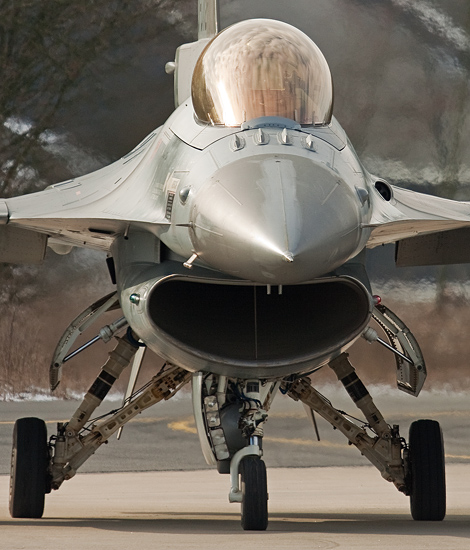
|
Wintertime Photography Part 2; Volkel February 16, 2010
Operating in a White Environment; Text and Photograph's by Alex van Noye
On Tuesday, February 16th, I went to Volkel airbase to see the Dutch F-16's of the Royal Netherlands Air
Force. The goal was to shoot photographs of these aircraft in winter conditions. This was not a problem
because Volkel was covered with snow. The Netherlands suffered relatively much snow this season for Dutch
standards.
The snowfall of last winter is already visible for several months. This creates some beautiful scenes for
aviation photography. For photography of snowy landscapes it is necessary to keep a few things in mind. The
cold weather conditions can have an impact on the performance of the camera. Manufacturers of cameras and
lenses often provide a minimum ambient temperature of zero degrees Celsius in their specs. A normal Dutch
winter doesn't cause any problems for a regular camera, but take care for drastic temperature changes.
Condensation may occur in the camera or lens when a camera or lens is brought from a cold to a warm
environment, for example when you're coming home from a trip. Keep the camera or lens inside the bag so
temperature can increase gradually.
The battery in a camera performs best in warmer temperatures. The colder the weather, the faster a battery
can become empty. Make sure that there are some spare batteries in your bag when you go out in very cold
weather. Do not keep those batteries in the cold camera bag, but in a warm place like the inside pocket of
your jacket. The cold weather may also have beneficial effects on the camera. Image sensors suffer generally
higher noise levels at very high temperatures and less noise levels at low temperatures. This is an effect
that normally happens at slow shutter speeds. With a long exposure time there is a sustained voltage on the
image sensor and it is warmed up because of this. This can be an advantage during the shooting of helicopters
and propeller planes.
Pay attention to the lighting when photographing aircraft in the snow. The camera's light measurement is
based on the "average subject". This corresponds to a value of 18% light gray. The camera will measure the
white snow as a highlighted gray. Automatic light measuring will result in most cases in too dark pictures.
|
|
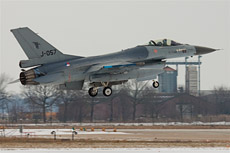
|
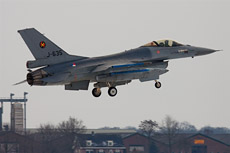
|
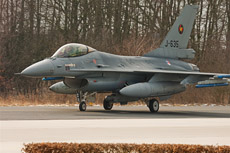
|
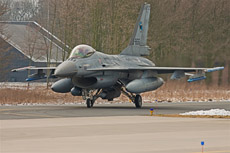
|
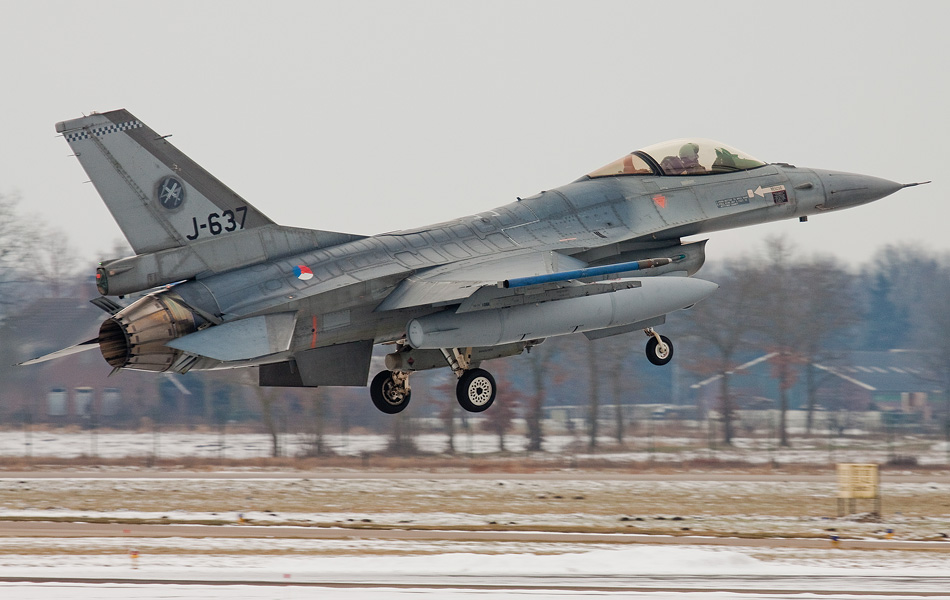
|
The rule is that generally up to two stops can be overexposed to expose the snow properly. This can also be
corrected in post processing software, but it often quickly creates extra noise in the picture. So it is
better to pay attention to this immediately during the photo shoot. You can do this by making a test picture
and watch the histogram of the photo. The histogram shows the amount of black, gray and white in photos. The
left side of the histogram represents black, white is shown on the right and the center point is neutral gray.
A properly exposed photo with snow on it will contain much white, so the histogram will be filled mainly on
the right side. Increase the exposure compensation if the histogram on the right remains empty (The photo
contains too much black in that case).
I arrived later than usual at Volkel. Normally the first F-16's would take off between half past nine and ten
am. Today I arrived at eleven am and I thought the F-16's were already gone for the morning flight. And yes
indeed most of the F-16's were already gone when I arrived. I was just able to catch the last QRA F-16 which
left Volkel at a few minutes past eleven. When I spoke to some other photographers, I heard that currently
eleven F-16's were in the air. This is quite much for an airbase like Volkel. The landscape was covered with
a thin layer of snow and that would result in some really beautiful photos later on. You can't shoot often
under these weather conditions in a country like the Netherlands. The photos you shoot on days like these are
very different from the ones you would normally have. The first F-16's reported for landing after about one
hour of waiting in the cold weather. It was past twelve already when the first aircraft arrived at Volkel.
The most beautiful part of photography of landing aircraft in snow is that the bottom is well illuminated by
the reflection of the snow.
We had to wait for one and a half hour when the morning flight returned before the afternoon flight would go
out. Due to the cold I decided to wait in the car so I could warm myself a bit there. The first F-16's would
start up their engines after a while and the base was alive again. The cloudy weather had now given way to
some watery winter sunshine. The first aircraft taxied to the runway about twenty minutes after the first
start up. Four F-16's of no 312 and no 313 squadron rolled along us and crossed the runway. They would line
themselves up neatly in a row on the platform in between the two parallel runways. This was a very nice photo
opportunity because the F-16's stood from our perspective quite close to each other. Another group of four
F-16's appeared right in front of us in the meantime. These F-16's were from no 311 and no 313 squadron.
One by one the fighters went airborne, followed by a silence that would not last long. Another pair of F-16's
appeared shortly after the take-off of this group of eight aircraft. These F-16's were positioned right in
front of us and we were able to take some really nice close ups of the aircraft. After these two F-16's had
taken off, it became silent again.
In the meanwhile, the sky opened completely and we had a clear blue winter sky above the airbase. After the
take-off of the ten F-16's, I moved myself to the road next to the head of the runway. From here I wanted to
shoot photographs of the incoming planes. The two F-16's that left at the end of the take-off session would
return to Volkel first. After some low-approaches they came in for a full stop. On the place where I stood I
was able to take photographs of the F-16's when they were turning in for final approach. This has to do with
the approach pattern which is in use at Volkel. The weather was really great at this moment for some
spectacular landing pictures, because the sky was clear blue and the sunlight on the F-16's was really great.
When all ten F-16's were in, it was time for me to go home. This day at Volkel was a big success with great
flying activities, great weather and beautiful photo opportunities. Also next to these great conditions I also
used my new camera for the first time.
|
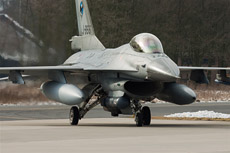
|
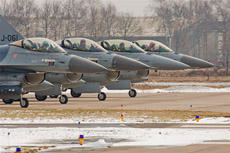
|
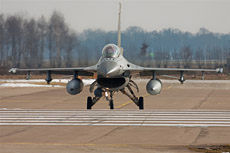
|
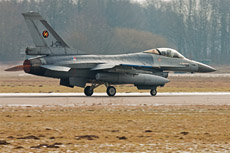
|
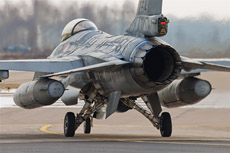
|
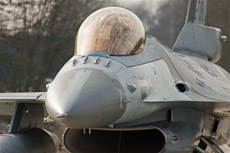
|
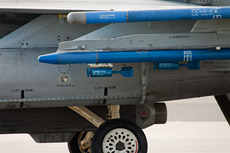
|
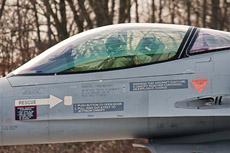
|
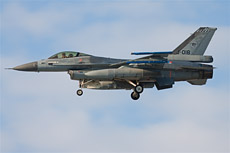
|
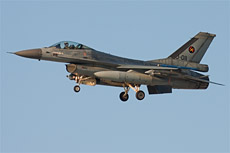
|
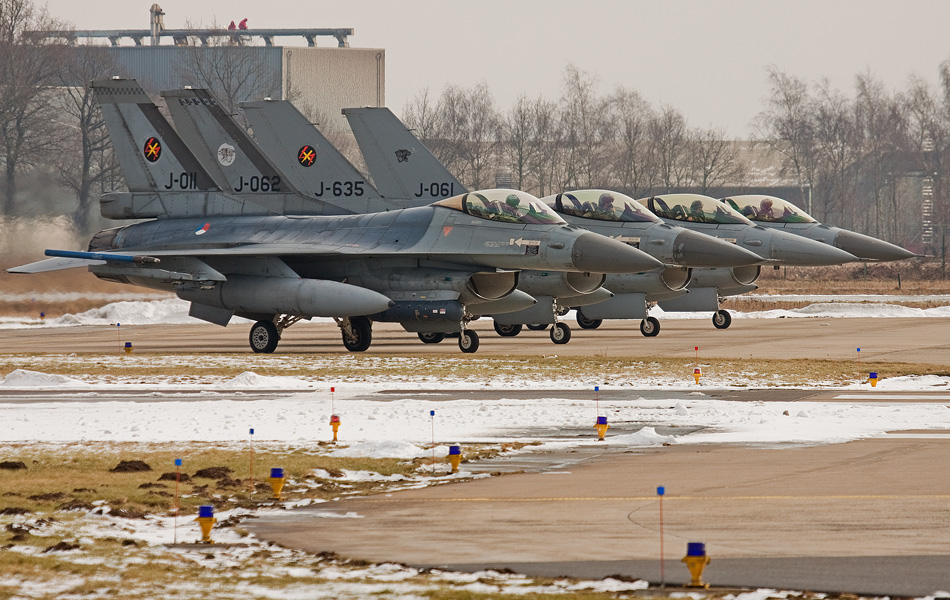
|
|
|

|







